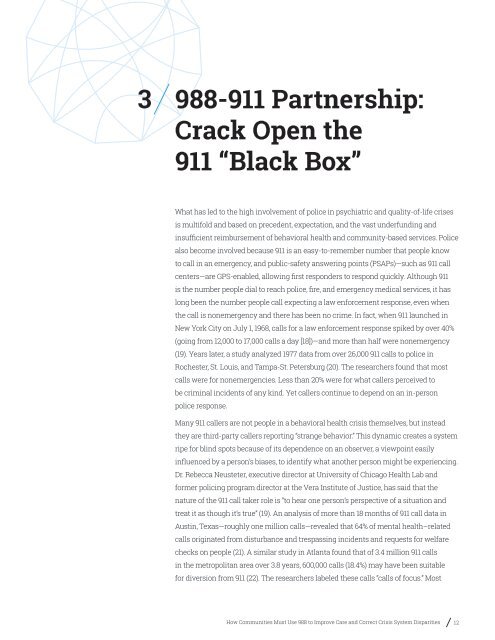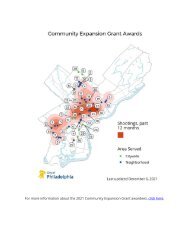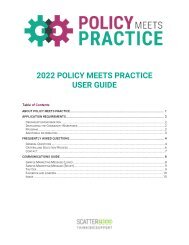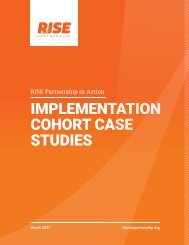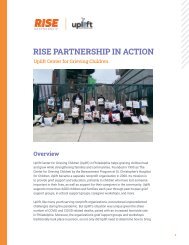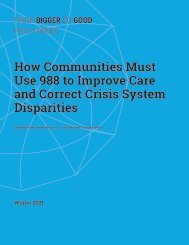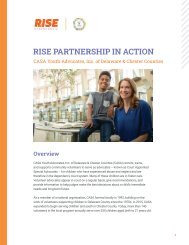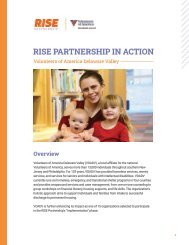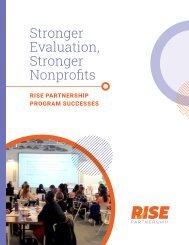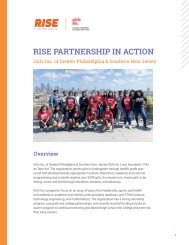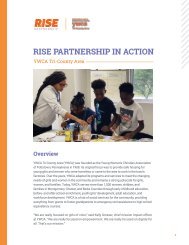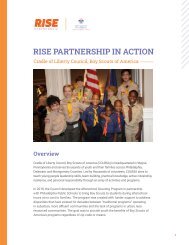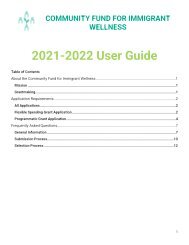How Communities Must Use 988 to Improve Care and Correct Crisis System Disparities
You also want an ePaper? Increase the reach of your titles
YUMPU automatically turns print PDFs into web optimized ePapers that Google loves.
3<br />
<strong>988</strong>-911 Partnership:<br />
Crack Open the<br />
911 “Black Box”<br />
What has led <strong>to</strong> the high involvement of police in psychiatric <strong>and</strong> quality-of-life crises<br />
is multifold <strong>and</strong> based on precedent, expectation, <strong>and</strong> the vast underfunding <strong>and</strong><br />
insufficient reimbursement of behavioral health <strong>and</strong> community-based services. Police<br />
also become involved because 911 is an easy-<strong>to</strong>-remember number that people know<br />
<strong>to</strong> call in an emergency, <strong>and</strong> public-safety answering points (PSAPs)—such as 911 call<br />
centers—are GPS-enabled, allowing first responders <strong>to</strong> respond quickly. Although 911<br />
is the number people dial <strong>to</strong> reach police, fire, <strong>and</strong> emergency medical services, it has<br />
long been the number people call expecting a law enforcement response, even when<br />
the call is nonemergency <strong>and</strong> there has been no crime. In fact, when 911 launched in<br />
New York City on July 1, 1968, calls for a law enforcement response spiked by over 40%<br />
(going from 12,000 <strong>to</strong> 17,000 calls a day [18])—<strong>and</strong> more than half were nonemergency<br />
(19). Years later, a study analyzed 1977 data from over 26,000 911 calls <strong>to</strong> police in<br />
Rochester, St. Louis, <strong>and</strong> Tampa-St. Petersburg (20). The researchers found that most<br />
calls were for nonemergencies. Less than 20% were for what callers perceived <strong>to</strong><br />
be criminal incidents of any kind. Yet callers continue <strong>to</strong> depend on an in-person<br />
police response.<br />
Many 911 callers are not people in a behavioral health crisis themselves, but instead<br />
they are third-party callers reporting “strange behavior.” This dynamic creates a system<br />
ripe for blind spots because of its dependence on an observer, a viewpoint easily<br />
influenced by a person’s biases, <strong>to</strong> identify what another person might be experiencing.<br />
Dr. Rebecca Neusteter, executive direc<strong>to</strong>r at University of Chicago Health Lab <strong>and</strong><br />
former policing program direc<strong>to</strong>r at the Vera Institute of Justice, has said that the<br />
nature of the 911 call taker role is “<strong>to</strong> hear one person’s perspective of a situation <strong>and</strong><br />
treat it as though it’s true” (19). An analysis of more than 18 months of 911 call data in<br />
Austin, Texas—roughly one million calls—revealed that 64% of mental health–related<br />
calls originated from disturbance <strong>and</strong> trespassing incidents <strong>and</strong> requests for welfare<br />
checks on people (21). A similar study in Atlanta found that of 3.4 million 911 calls<br />
in the metropolitan area over 3.8 years, 600,000 calls (18.4%) may have been suitable<br />
for diversion from 911 (22). The researchers labeled these calls “calls of focus.” Most<br />
<strong>How</strong> <strong>Communities</strong> <strong>Must</strong> <strong>Use</strong> <strong>988</strong> <strong>to</strong> <strong>Improve</strong> <strong>Care</strong> <strong>and</strong> <strong>Correct</strong> <strong>Crisis</strong> <strong>System</strong> <strong>Disparities</strong> 12


